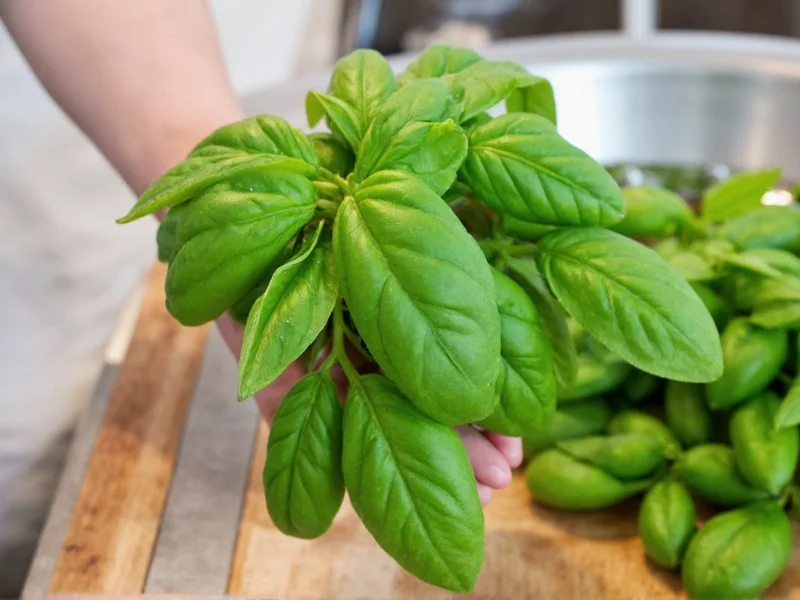Understanding how to properly convert dried basil to fresh measurements is essential for achieving balanced flavors in your cooking. While fresh basil offers bright, aromatic notes, dried basil provides a more concentrated, earthy flavor profile that requires careful measurement adjustment.
Why the 1:3 Conversion Ratio Matters
Dried basil contains approximately three times the flavor concentration of fresh basil because the drying process removes moisture while preserving essential oils. When herbs lose their water content, the remaining compounds become more potent. This scientific principle explains why using equal measurements would result in overpowering, bitter dishes.
Practical Substitution Guidelines
When converting recipes that call for fresh basil to use dried instead, follow these professional chef recommendations:
| Recipe Requirement (Fresh) | Dried Basil Substitute | Best Application |
|---|---|---|
| 1 tablespoon fresh | 1 teaspoon dried | Sauces, soups, stews |
| ¼ cup fresh | 1¼ tablespoons dried | Casseroles, braises |
| ½ cup fresh | 2½ tablespoons dried | Tomato-based sauces |
| 1 cup fresh | ⅓ cup dried | Long-cooking dishes |
Flavor Profile Differences You Should Know
Fresh basil features bright, sweet notes with hints of anise and pepper, while dried basil develops deeper, more earthy characteristics with subtle mint undertones. The drying process alters volatile compounds, resulting in these distinct flavor profiles. Understanding dried basil equivalent to fresh basil measurements helps maintain recipe balance despite these differences.
Chefs recommend adding dried basil early in the cooking process to allow time for rehydration and flavor development, whereas fresh basil typically goes in during the final minutes to preserve its delicate aroma. This timing difference represents another crucial aspect of proper dried herbs to fresh conversion.
Maximizing Flavor When Substituting
For optimal results when using dried basil instead of fresh, consider these professional techniques:
- Bloom dried basil in warm olive oil for 5-10 minutes before adding to dishes
- Crush between fingers before adding to release essential oils
- Add early in cooking for sauces and soups to allow full flavor integration
- Reduce quantity by 25% for delicate dishes like fish or egg preparations
- Combine with fresh parsley to approximate fresh basil's brightness
When Not to Substitute
Certain dishes simply won't achieve the same results with dried basil. Avoid substitution in these situations:
- Pesto recipes (fresh basil's texture and moisture are essential)
- Garnishes for finished dishes
- Ceviche or other raw preparations
- Caprese salad and similar fresh presentations
- When making basil oil or infused vinegars
Storage Tips for Maximum Freshness
Proper storage significantly impacts how well your dried basil performs as a fresh substitute:
- Store dried basil in airtight containers away from light and heat
- Replace dried herbs every 6-12 months for optimal potency
- Keep fresh basil stems in water at room temperature (never refrigerate)
- Freeze fresh basil in olive oil for longer preservation
- Test dried basil freshness by rubbing and smelling—weak aroma means it's past prime
Common Conversion Mistakes to Avoid
Many home cooks make these critical errors when substituting dried basil for fresh:
- Using equal measurements without adjustment
- Adding dried basil at the same stage as fresh would be added
- Not accounting for regional basil variety differences
- Using old, stale dried basil that has lost potency
- Substituting in dishes where fresh basil's texture is essential
Remember that the dried basil to fresh basil conversion ratio serves as a starting point. Personal taste preferences, specific recipe requirements, and the quality of your herbs may necessitate slight adjustments. Always taste as you cook and adjust seasoning accordingly.
Understanding Herb Potency Variations
Not all dried basil products offer identical potency. Commercially dried herbs often undergo different processing methods that affect their strength. When working with dried basil equivalent to fresh basil measurements, consider these factors:
- Home-dried basil typically retains more flavor than commercially dried
- Organic dried basil often has stronger flavor than conventionally processed
- Finely ground dried basil releases flavor more quickly than coarsely ground
- Brands vary significantly in concentration—taste before measuring
For the most accurate dried herbs to fresh conversion, develop the habit of tasting your dried basil before use. Rub a small amount between your fingers, smell it, and even taste a tiny pinch to assess its current potency level.











 浙公网安备
33010002000092号
浙公网安备
33010002000092号 浙B2-20120091-4
浙B2-20120091-4